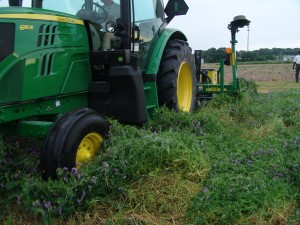As planting nears, people are beginning to decide how and when to terminate their cover crop. Cover crops are utilized for many reasons. However with respect to weed suppression, cover crops should be managed “crop specifically”, not unlike how we think of PRE herbicides. Factors that go into this decision will include cover crop specie(s), what the following crop is, and the size/stage of the cover crop.
Cereal covers (cereal rye, wheat, etc…) are commonly utilized for weed control because of their effectiveness and cost. For soybeans, termination of these covers can be delayed all the way until at or shortly before planting. Soybeans are very tough early season and can tolerate a substantial cereal cover if the planter is set correctly. Corn, however, will respond negatively to an overly delayed termination of a cereal cover. In our research, we saw negative impacts on corn height and vigor from cereal rye terminated 0, 14, or 28 days prior to planting in comparison to vetch, vetch + rye, or no cover crop (standard no-till). Although this did not translate into a yield reduction, last year was also very conducive to making a corn crop and no other significant crop stresses occurred at our location. Cotton would fall somewhere between corn and soybeans. Cotton can tolerate and even benefit from a cereal cover if the cover is not allowed to get too big (24-30in); however, correctly setting the planter to achieve seed soil contact is imperative.
Another thing to consider with cereals is whether or not you have to ability to ‘roll’ the cover crop. A roller crimper is an implement that lays the cover crop biomass flat to the ground, allowing the crop to come up with no standing competition and putting more of a barrier for weeds on the soil surface. In our research, a roller crimper has only proven effective for cover termination/weed control once the cover has reached reproductive stages. Use prior to this point will require the addition of a herbicide for termination and likely not contribute much to weed control. The ability to use a roller crimper can greatly increase the amount of biomass allowable for cotton or soybeans going behind a cereal cover. However, if a cereal cover has gotten large enough to terminate with a roller crimper, it will likely also have a negative impact on corn growth.
Legume covers can be utilized for weed control and/or their value as a source of N. We have been predominately looking at legume covers of hairy vetch or crimson clover because of their high biomass and ability to suppress weeds. Legume covers are very compatible with crops like corn or cotton that respond well to early season N, but it should be noted that once the above ground biomass from the cover begins to break down, a flush of weeds will quickly ensue. Delaying termination will also delay the weed flush, but it is vital to scout fields closely and make a timely herbicide application. Time and again we have found that running a planter over vetch that is near maturity terminates most of the vetch. Therefore, unlike cereals, rolling a vetch cover crop to terminate it will not add much over what a planter will accomplish.
A 2-way mix of one of the aforementioned legume and cereal species has provided more weed suppression than either by itself. In our research, the addition of vetch to cereal rye increased corn height and vigor when terminated 14 days before planting compared to conventional no-till. Termination for cotton would fall in a similar window to corn, and termination prior to soybeans can be delayed all the way until planting with no negative impacts on growth or yield. Additionally, with respect to a vetch + cereal cover crop mix, the planter alone will give you the ‘rolled’ effect and is at least partially why termination with these can be delayed without impacting the crop.
Some additional things to keep in mind are that if you are delaying cover crop planting to less than 14 days prior to planting there is potential for a ‘Green Bridge’ and insect issues could be prevalent. Last year we experienced cutworms in corn and three cornered alfalfa hoppers in soybeans and cotton where we delayed termination.



Very good article “When should I terminate my cover crop?”
there may be a ‘typo’ in the last paragraph. You wrote, “…delaying cover crop planting to <14 days prior to planting…" Please examine this.
Thank you!
Rick,
Thank you for the compliment and input. Post has been edited for clarity.
Garret
In our experience so far w/ cover crops, Anything not a legume has lowered our yields of corn, milo, or soybeans, especially if we wait to kill the cover crop less than 30 days before planting time. It is certainly an added cost for so little gain or even loss & the only way we can keep it close to profitable is to put a cow into the program. Grant